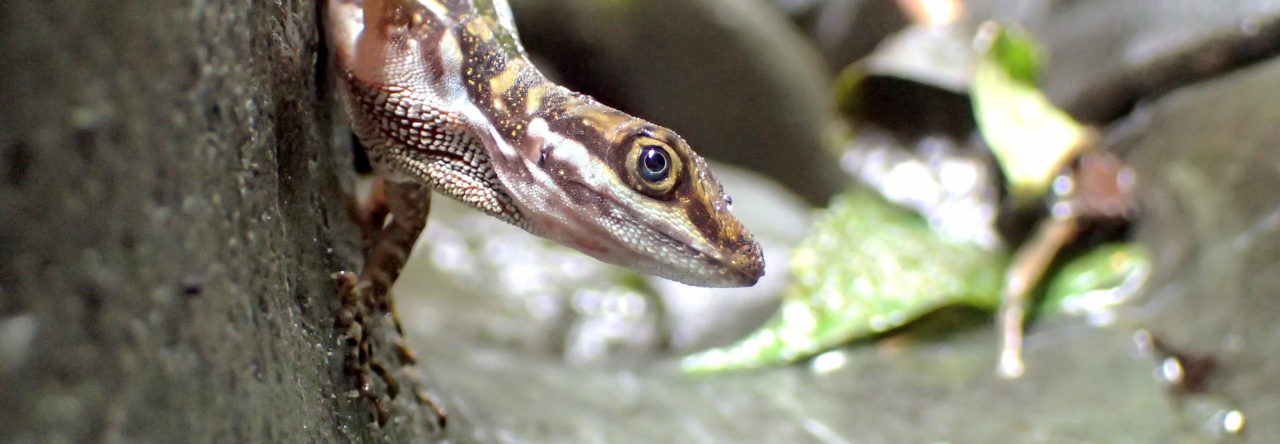Up high displaying green anole. Photo from this website, which has some nice other reptile shots.
Many animals use different parts of their habitat for different activities–eating in one place, mating in another, and so on. This hasn’t been studied in many anoles, but has been documented in several. In addition, many species alter their habitat use in the presence of competitors, and this has been widely demonstrated in anoles. However, few have studied the interaction of the two phenomena: is the extent of behavioral partitioning among habitats affected by the presence of competitors?
To address this question, Ambika Kamath and colleagues studied green anoles on several islands in Mosquito Lagoon in the Intracoastal Waterway of Florida. In this area, a number of small “spoil” islands were created when the waterway was dredged half a century ago. These islands were quickly colonized by plants–and now are covered with very large trees–and then by green anoles. More recently, the invasive brown anoles have arrived on the scene on some of the islands.
Kamath et al., whose research was recently published in a paper in Breviora, chose four islands, two with brown anoles, two without (freely available, as are all MCZ publications, on the museum’s website). On these islands, they recorded habitat use and behavior. As predicted animals forage at lower heights than where they perch. One possible explanation is that they sit at vantage points looking for prey, then go down and catch them. And as predicted, males display at particularly high spots. The explanation here is not clear, but as reported recently for A. cuvieri, males seem to like to display higher than their rivals. Finally, once more as predicted, in the presence of brown anoles, green anoles shift upwards in all respects.
The interesting finding, however, is that the shift is essentially parallel for all activities. Animals move downward the same amount to capture prey and upward the same amount to display. This would suggest that there is not an optimal height for feeding or displaying, or perhaps that the optimal height changes in the presence of brown anoles. That would be readily understandable with regard to feeding–the voracious brown anoles probably vacuum up the low-lying food, so no point in dropping down as low to feed as in their absence. Why males continue to move up even higher is less obvious, though it may be just that competitors are now perching higher, so a male has to go higher yet to display above them.
This paper represents the sort of detailed behavioral study that is all too infrequent for anoles. How these lizards modulate their behavior in response to conditions is fascinating and often surprising. Much remains to be learned, and most anole species–well, at least in the Caribbean–are amenable to behavioral observation.
- Evolution in Real Time on Lizard Island - March 23, 2025
- Spider Snags Adult Anolis osa - March 22, 2025
- An Homage to the Green Anoles of New Orleans - March 21, 2025


Jeffrey Himmelstein
For the past few days I have observed a particularly large population of the Northern Curly Tailed Lizard, Leiocephalus carinatus, on a well manicured lawn/planted shrub habitat with several Areca Palms, Dypsis lutescans, in Sunrise, Florida There is a small population of A. sagrei which are only observed on the trunks of the Areca and virtually never seem to descend down to ground level.